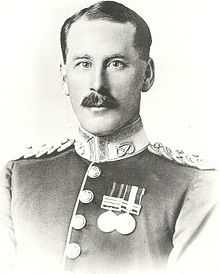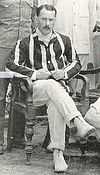Charles Lyon
| Charles Harry Lyon | |
|---|---|
 C H Lyon pictured in India 1908 when adjutant of 2nd Battalion, North Staffordshire Regiment | |
| Born |
18 March 1878 Rocester, Staffordshire |
| Died |
3 December 1959 (aged 81) Ightfield, Shropshire |
| Allegiance | British |
| Service/branch | Army |
| Years of service | 1900–1933 |
| Rank | Brigadier-General |
| Unit | North Staffordshire Regiment |
| Awards |
CB CMG DSO |
| Other work | Land Tax Commissioner |
Charles Harry Lyon CB, CMG, DSO (18 March 1878 – 3 December 1959) was an English soldier who also played first class cricket for Derbyshire in 1902.
Early life
Lyon was born at The Lodge, Rocester, Staffordshire, the eldest son of Charles William Lyon and his wife Florence. His father was a cotton manufacturer who ran a mill at Rocester and was a Justice of the Peace.[1]
Military career
Lyon was commissioned as a Second Lieutenant into the 4th (Extra Reserve) Battalion, the North Staffordshire Regiment in February 1900.[2] In April of the same year he was posted to the 2nd Battalion of the regiment[3] The 2nd Battalion was a regular battalion and was at the time on active service in South Africa during the Second Boer War where Lyon joined the battalion and served with it throughout the war being Mentioned in Despatches in 1901.[4] Returning to England as a Lieutenant in 1902 Lyon remained with the 2nd Battalion when it was posted to India in 1903 where he became adjutant[5] and was promoted to Captain.[6]
In 1912 Lyon was seconded as a student to the Staff College, Camberley[7] Upon leaving the Staff College, Lyon was posted to the 1st Battalion which was then in Ireland and was still with the 1st Battalion at the outbreak of the First World War. The battalion mobilised in August 1914 and went to France in September,[8] but Lyon only remained with the battalion for another month until October 1914 when he was attached to the General Staff as a Staff Captain. This was the first of many staff posts that Lyons held until the end of his career and he never returned to regimental duty. In March 1915 Lyon moved to the staff of the Quartermaster general and by the end of the war held the substantive rank of Major, the brevet rank of Lieutenant-Colonel and the temporary rank of Brigadier-General.[9] He was awarded the Distinguished Service Order (DSO) in the New Year's Honours List for 1916,[10] appointed a Companion of the Order of St Michael and St George (CMG) in January 1918,[11] and made a Companion of the Order of the Bath;[9] as well as two Belgian decorations, being made an Officier de l'Ordre de la Couronne[12] and the Croix de guerre[13]
Post war Lyon served as Assistant Director of Quartering at the War Office[14] before finishing his career as Assistant Quarter Master General,[15] retiring on half pay in 1927 with the honorary rank of Brigadier-General.[16]
Cricketing career

Between his return from South Africa and his departure for India Lyon played two first-class cricket matches for Derbyshire in the 1902 season. The first was in a match against Worcestershire, which resulted in a draw. Less than a week later, Lyon made his only other first-class appearance, against Nottinghamshire. He was a right-handed batsman and made 6 runs in his 2 matches. He bowled 2 overs without taking a wicket.[17]
After World War I, Lyon played cricket for the Free Foresters.
Private life
Lyon married Gwenlliam Mary Campbell, a member of the Minton pottery family, they had one daughter, Frances Mary Lyon. After his retirement from the Army Lyon settled in Ightfield, Shropshire became a Land Tax Commissioner for the county of Shropshire.[18] He died at Ightfield in 1959 and left an endowment, the Charles Harry Lyon Endowment, managed by the charity Ightfield with Calverhall Village Hall and Playing Field to manage the land and buildings held by the committee, for the villagers, clubs and wider community of Ightfield.[19]
References
- Notes
- ↑ Census Returns of England and Wales, 1881, The National Archives, Piece 2749, Folio 33, page 20
- ↑ The London Gazette: no. 27164. p. 1005. 13 February 1900. Retrieved 26 March 2012.
- ↑ The London Gazette: no. 27205. p. 3970. 26 June 1900. Retrieved 26 March 2012.
- ↑ The London Gazette: no. 27353. p. 5948. 10 September 1901. Retrieved 26 March 2012.
- ↑ The London Gazette: no. 27961. p. 7218. 26 October 1906. Retrieved 26 March 2012.
- ↑ The London Gazette: no. 28236. p. 2350. 26 March 1909. Retrieved 26 March 2012.
- ↑ The London Gazette: no. 28575. p. 645. 26 January 1912. Retrieved 26 March 2012.
- ↑ History of the 1st & 2nd Battalions The North Staffordshire Regiment (The Prince of Wales'), 1914–1923 1932, p. 15.
- ↑ 9.0 9.1 The London Gazette: (Supplement) no. 31370. p. 6790. 30 May 1919. Retrieved 26 March 2012.
- ↑ The London Gazette: (Supplement) no. 29438. p. 573. 11 January 1916. Retrieved 26 March 2012.
- ↑ The Edinburgh Gazette: (Supplement) no. 13186. p. 11. 2 January 1918. Retrieved 26 March 2012.
- ↑ The Edinburgh Gazette: no. 13052. p. 368. 16 February 1917. Retrieved 26 March 2012.
- ↑ The London Gazette: (Supplement) no. 30568. p. 3096. 8 March 1918. Retrieved 26 March 2012.
- ↑ The London Gazette: no. 32765. p. 7940. 10 November 1922. Retrieved 26 March 2012.
- ↑ The London Gazette: no. 32796. p. 1151. 16 February 1923. Retrieved 26 March 2012.
- ↑ The London Gazette: no. 33255. p. 1524. 8 March 1927. Retrieved 26 March 2012.
- ↑ "Charles Lyon". Cricket Archive. Cricket Archive. Retrieved 26 March 2012.
- ↑ The London Gazette: no. 34504. p. 2629. 22 April 1938. Retrieved 26 March 2012.
- ↑ "Charles Harry Lyon Endowment". Opencharities.org. Retrieved 26 March 2012.
- Sources
- History of the 1st & 2nd Battalions The North Staffordshire Regiment (The Prince of Wales'), 1914–1923. Longton: Royal Press. 1932.